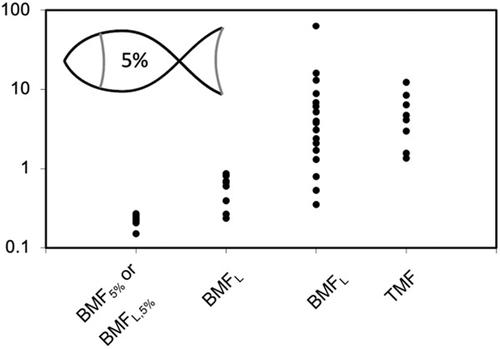当前位置:
X-MOL 学术
›
Environ. Toxicol. Chem.
›
论文详情
Our official English website, www.x-mol.net, welcomes your
feedback! (Note: you will need to create a separate account there.)
Normalizing the Biomagnification Factor
Environmental Toxicology and Chemistry ( IF 3.6 ) Pub Date : 2020-12-08 , DOI: 10.1002/etc.4953 Frank A P C Gobas 1 , Yung-Shan Lee 1 , Jon A Arnot 2, 3, 4
Environmental Toxicology and Chemistry ( IF 3.6 ) Pub Date : 2020-12-08 , DOI: 10.1002/etc.4953 Frank A P C Gobas 1 , Yung-Shan Lee 1 , Jon A Arnot 2, 3, 4
Affiliation

|
Following a recent proposal of normalizing the experimentally derived biomagnification factor (BMF) to a 5% lipid content in fish, we explore the normalization of the BMF of lipophilic chemicals in fish. We illustrate with theoretical models and experimental data that the BMF of lipophilic chemicals is a function of the lipid content of the diet and that poorly metabolizable, lipophilic chemicals biomagnify in organisms to a greater degree when present in higher–lipid content food. The proposed normalization of the laboratory BMF to the lipid content of the fish and subsequent standardization to a 5% fish lipid content, which is numerically identical to normalizing the BMF to a 5% dietary lipid content, has the potential to underestimate the biomagnification potential of lipophilic substances in aquatic food webs. The BMF normalized to both the lipid content of the fish and the lipid content of the diet, which is the biomagnification metric included in the Organisation for Economic Co‐operation and Development's bioaccumulation testing guideline 305, better represents real‐world biomagnification than the proposed BMF normalized and standardized to a 5% lipid content in fish. Environ Toxicol Chem 2021;40:1204–1211. © 2020 SETAC
中文翻译:

标准化生物放大系数
根据最近将实验衍生的生物放大因子 (BMF) 归一化为鱼中 5% 的脂质含量的提议,我们探索了鱼类中亲脂性化学物质的 BMF 的归一化。我们用理论模型和实验数据说明亲脂性化学物质的 BMF 是饮食中脂质含量的函数,并且当存在于高脂质含量的食物中时,不易代谢的亲脂性化学物质在生物体中的生物放大程度更大。建议将实验室 BMF 标准化为鱼的脂质含量,随后标准化为 5% 的鱼脂含量,这在数值上与将 BMF 标准化为 5% 的膳食脂质含量相同,有可能低估了鱼的生物放大潜力。水生食物网中的亲脂性物质。环境毒理学化学2021;40:1204-1211。© 2020 SETAC
更新日期:2020-12-08
中文翻译:

标准化生物放大系数
根据最近将实验衍生的生物放大因子 (BMF) 归一化为鱼中 5% 的脂质含量的提议,我们探索了鱼类中亲脂性化学物质的 BMF 的归一化。我们用理论模型和实验数据说明亲脂性化学物质的 BMF 是饮食中脂质含量的函数,并且当存在于高脂质含量的食物中时,不易代谢的亲脂性化学物质在生物体中的生物放大程度更大。建议将实验室 BMF 标准化为鱼的脂质含量,随后标准化为 5% 的鱼脂含量,这在数值上与将 BMF 标准化为 5% 的膳食脂质含量相同,有可能低估了鱼的生物放大潜力。水生食物网中的亲脂性物质。环境毒理学化学2021;40:1204-1211。© 2020 SETAC











































 京公网安备 11010802027423号
京公网安备 11010802027423号